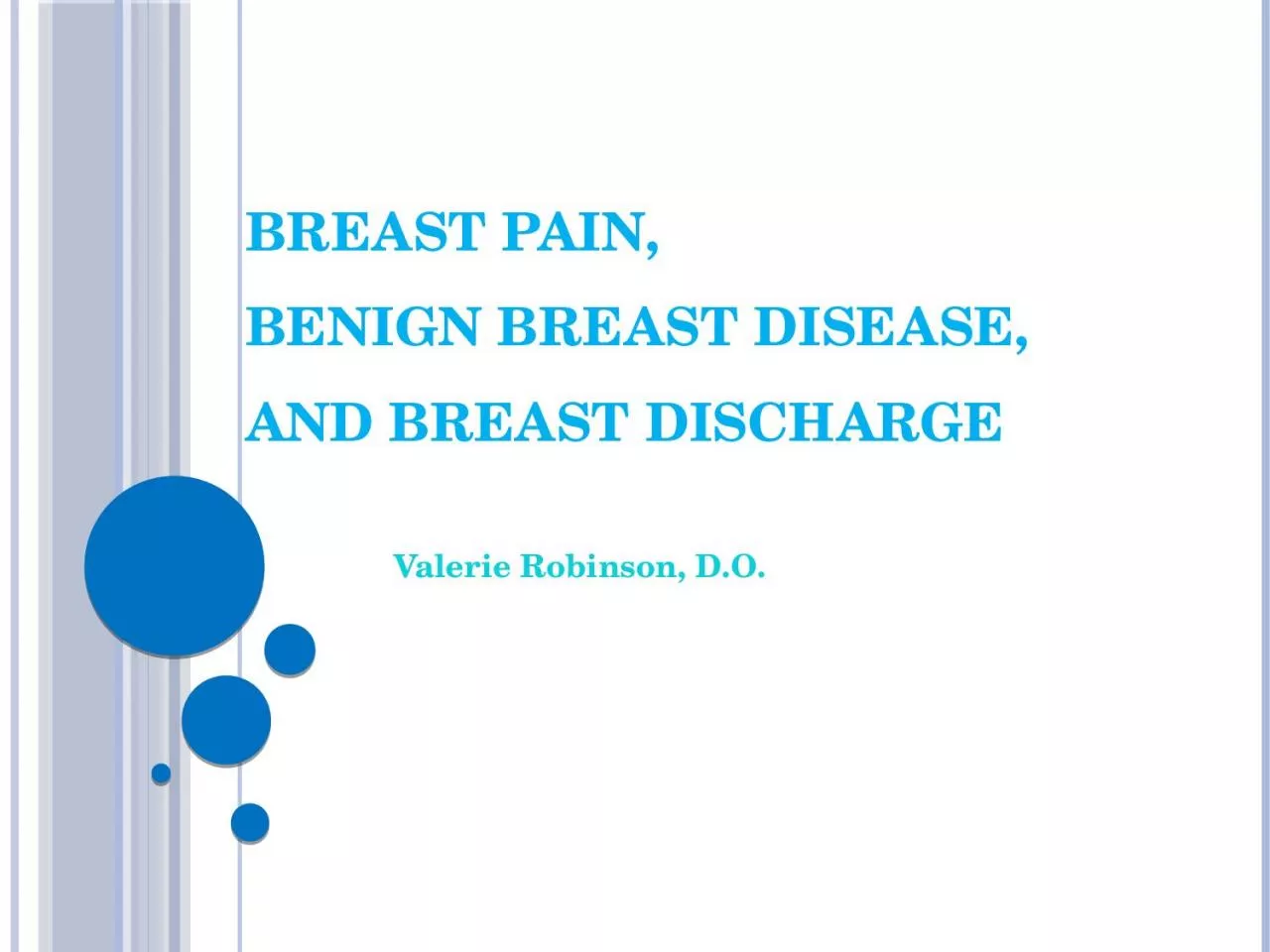

and Breast Discharge Valerie Robinson DO Breast Pain Cyclical 23 Noncyclical 13 Does not increase risk for breast cancer Most frequent cause in men is gynecomastia Cyclical Breast Pain ID: 1045046
Download Presentation The PPT/PDF document "Breast Pain, Benign Breast Disease," is the property of its rightful owner. Permission is granted to download and print the materials on this web site for personal, non-commercial use only, and to display it on your personal computer provided you do not modify the materials and that you retain all copyright notices contained in the materials. By downloading content from our website, you accept the terms of this agreement.
1. Breast Pain,Benign Breast Disease, and Breast DischargeValerie Robinson, D.O.
2. Breast PainCyclical = 2/3 Noncyclical = 1/3Does not increase risk for breast cancerMost frequent cause in men is gynecomastia
3. Cyclical Breast PainUsually presents the week before mensesUsually worst in the upper outer quadrantUsually bilateral and diffuseMay be related to fibrocystic breast changesOccurs during the late luteal phase, stimulates proliferation of glandular breast tissueEstrogen stimulates ductsProgesterone stimulates stromaProlactin stimulates ductal secretionsMay be caused by OCPs or HRT
4. Noncyclical Breast PainMay be unilateral or bilateralDuctal EctasiaInflammation and distention of subareolar ducts local pain, lipid infiltration of duct, feverMastitisObstruction in lactating women infection, swelling, diffuse pain, rednessInflammatory Breast CancerRapidly progressing tender, firm, peau d’orange
5. Noncyclical Breast Pain - ContinuedLarge Breasts – stretch Cooper’s ligamentHRTHidradenitis suppurtivaPregnancyThrombophlebitisSurgical scar tissue
6. Extramammary PainChest wall painPectoralis majorCostochondritisRib arthritisTraumaPostthoracotomy syndromeHealing chest wound simulates suckling. Elevated prolactin, breast pain, lactationCervical radiculopathyPleuritisCardiac ischemia
7. Breast Pain - DiagnosisHistory – location, onset, unilateral or bilateral, cyclic?, medications, pregnancy, exercisePhysical – mass, discharge, skin changes, tenderness, lymph nodesConsider mammogram (best for >35y) or U/SProlactin level if galactorrhea
8. Breast Pain - TreatmentReassuranceSupportive, well-fitting braWarm or cold compressesNSAIDsConsider reducing estrogen content in OCP, or HRT or changing other medsMay start OCP if cyclical breast painMay use tamoxifen if severe pain
9. Benign Breast DiseaseNonproliferativeProliferative without atypiaAtypical hyperplasiaOther Lesions
10. Terminal duct lobular unitLobular stromaSmooth muscleLarge ducts and lacti erous sinusesPectoralis muscleChest wall and ribsInterlobular stroma
11. NonproliferativeSimple CystCommon in age 35-50Occur at the terminal duct lobular unitMild ductal hyperplasiaEpithelial layer is 2-4 cells deepBenign epithelial calcificationsFound in ducts, lobules, stroma, or blood vesselsPapillary apocrine changeIntraductal proliferation of epithelial cells showing apocrine features with eosinophilic cytoplasm
12. Proliferative Without Atypia1.5-2 times risk of breast cancerUsual ductal hyperplasiaIntraductal papillomas, solitary or multipleMay present as a mass or with dischargeMay hide DCISTx with excisional biopsyRadial scarsComplex sclerosing lesions that have a fibroelastic core with radiating ducts and lobulesMay be premalignantTx with excision
13. Proliferative Without Atypia – Cont.Sclerosing adenosisMay present as a massLobular lesion with increased fibrous tissueFibroadenomasBenign solid tumor with fibrous and glandular tissueWomen of reproductive ageWell-defined, mobile massDx: needle biopsyTx: not necessary if asymptomatic and stableComplex FibroadenomasInclude areas of other nonproliferative or proliferative change
14. Atypical Hyperplasia3.7-5.3 times risk of breast cancerAtypical Ductal HyperplasiaProliferation of epithelial cells with monomorphic round nuclei filling part of the ductAtypical Lobular HyperplasiaMonomorphic, evenly spaced, dyshesive cells filling part of the lobuleTx: avoid OCPs and HRTMay consider tamoxifen or raloxifeneColumnar Cell HyperplasiaEpithelial cells change from squamous to columnar
15. OtherGalactocele aka milk retention cystDiabetic Mastopathy aka Lymphocytic MastitisDM1 premenopausal womenDense fibrosis, Periductal, lobular, or perivascular lymphocytic infiltrationLipomaFat necrosisResult of trauma or surgeryHamartomaComposed of glandular, adipose and fibrous tissueDiscrete, encapsulated, painless massAdenomaIdiopathic granulomatous mastitisPseudoangiomatous stromal hyperplasia (PASH)Stromal proliferation simulates an angioma
16. Breast DischargeBenignUsually bilateral, multiductal, occurs with manipulationPathologicSpontaneous, bloody, unilateral, uniductal, women >40, breast mass
17. BenignLactationPostpartum production of colostrum and milk. It is okay to contain some blood.Lasts up to 6 months after disuse.GalactorrheaMilky, yellow, brown, gray, greenUnilateral or bilateralHyperprolactinemiaPituitary adenomaMedication (haloperidol, phenothiazine, clomipramine, metoclopramide, morphine, methyldopa, verapamil)Neurogenic stimulation (irritation, postthoracotomy)PurulentPeriductal mastitisGrossly bloodyIntraductal benign fibrocystic changes, bleeding papilloma
18. Pathologic5-15% progress to cancer, risk increases with age >40Serous, sanguinous, or serosanguinousMCC is papilloma Intraductal breast carcinomaMost common malignancy with drainage is breast ductal carcinoma in situ (DCIS)Grossly bloody discharge may be caused by DCIS, or invasive carcinomaPaget’s Disease
19. ReferenceMehra Golshan, MD, Dirk Iglehart, MD. “Breast Pain.” UpToDate. Updated: May 2, 2012. Michael S Sabel, MD. “Overview of benign breast disease.” UpToDate. Updated: Jun 25, 2012. Mehra Golshan, MD, Dirk Iglehart, MD. “Nipple Discharge.” UpToDate. Updated: June 4, 2012.